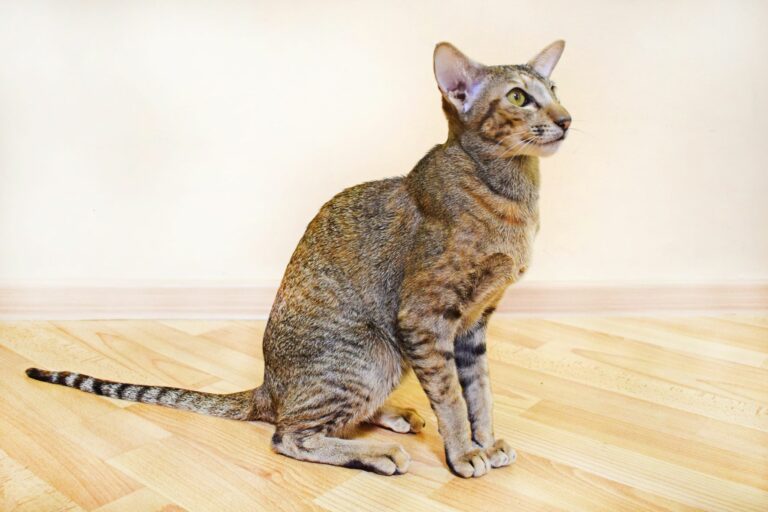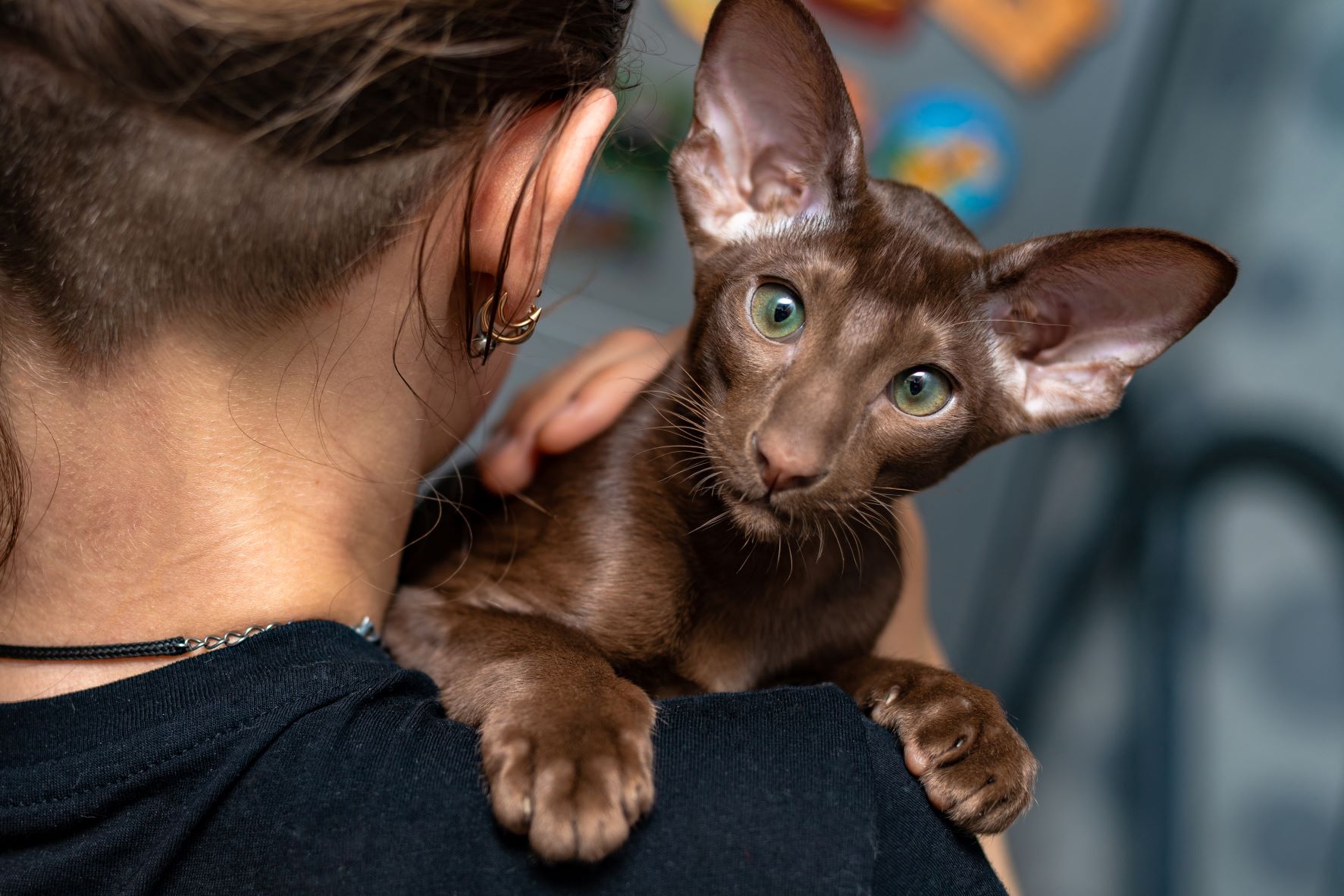Maine Coon
The Maine Coon has now become one of the most popular cat breeds in the world and is enjoying increasing popularity in Ireland, too. This is probably thanks to its authenticity, robustness and excellent character.
Things certainly won't be boring with an Oriental Shorthair, also known as the OSH. These intelligent, lively cats with big ears need plenty of attention and don't like being alone. In return, they reward their human family with lots of affection.

© Oksana Zhigulina / stock.adobe.com
Typical Oriental Shorthair: Big ears, green eyes, long legs.
The Oriental Shorthair’s most striking feature is its large bat ears. They are far apart, broad at the base and then taper to a point.
OSHs have a striking wedge-shaped head with a long, straight nose. According to the breed standard, their almond-shaped, slightly slanted eyes are bright green – no matter what their fur colour. However, Oriental Shorthairs can also have blue eyes. Some cats have one green and one blue eye.
Oriental Shorthairs descend from Siamese cats and have a similar physique: they are slender with long legs. The Oriental Shorthair’s tail is long, thin and resembles a whip.
OSHs are a medium-sized cat breed: Females weigh between 3 and 4kg, whilst males weigh up to 5kg.
The short, fine, close-lying fur also contributes to the slender appearance. It has an attractive shine and no undercoat.
The wide range of fur colour and markings is typical of this cat breed. Here are the most common colours and patterns for the OSH:
Tabby is the generic term for numerous typical cat patterns. All tabby cats have an M-shaped marking on their forehead.
OSH cats are very playful, curious and people-focused. They want to be included in all the family’s activities and are vocal about it. Their conviction is to be part of things and not just a bystander. An Oriental Shorthair will follow you wherever you go – to the toilet too if necessary.
They are also very intelligent. Some are even able to open doors and drawers. Clicker training is a good option to occupy these smart felines.
Like their relatives, Siamese cats, Oriental Shorthairs also meow a lot. If your OSH talks to you, it expects an answer from you.
You will find a large range of cat toys in the zooplus store to occupy your Oriental Shorthair.
 © Svyatoslav Balan / stock.adobe, com
© Svyatoslav Balan / stock.adobe, com
If you want an Oriental Shorthair to form part of your life, you should know that these cats require plenty of time and devotion.
OSH cats don’t like being alone and need company in order to be happy. They particularly like spending time with fellow OSHs. So if you work and don’t have much time, you’re better off getting two Oriental Shorthairs.
These cats enjoy having a garden or secured balcony, but are also satisfied as indoor cats. Most Oriental Shorthairs are also up for walks on a lead.
Due to the short hair and lack of an undercoat, the OSH’s fur is very easy to groom. Gently rub down the fur with a damp flannel to make it even shinier.
Regular brushing isn’t necessary with this cat breed, although it does enjoy the attention associated with grooming. You can also simply stroke your pet’s fur with damp hands to get rid of loose hairs.
Oriental Shorthairs are considered robust animals, although they are quite sensitive to the cold. Their average life expectancy is 15 years of age.
In contrast to their relatives, Siamese cats, there are no known breed-specific diseases with the OSH – whilst the Siamese tends to have problems with its eyes, heart as well as certain types of cancer.
Nevertheless, the OSH isn’t immune to normal feline diseases and parasites. Hence, make sure it gets the required vaccinations and take your cat to the vet once a year for a health check.
Would you like to give an Oriental Shorthair a home? You can get an OSH from a breeder, for instance.
However, you should make sure before buying that the cats are housed in a species-appropriate manner. A reputable breeder has nothing to hide and will happily show you the kitten’s parents too.
Make sure paperwork is complete and that kittens are no younger than 12 weeks before you take them home. Before they are handed over, kittens should be vaccinated, microchipped and dewormed. If this isn’t the case, you’re better off looking elsewhere.
There are usually several ads for OSHs online. However, animal welfarists advise against buying cats online, because animals from such providers aren’t always treated in a species-appropriate manner. There is often a lack of space, hygiene and the right medical provision.
You can get an Oriental Shorthair from 600 euros upwards.
Perhaps you may also strike lucky in your local animal shelter. It’s not at all uncommon even for pedigree cats to end up in an animal shelter. Animal shelters generally give cats away for a low nominal fee. This fee should at least partially cover the costs of food, accommodation and trips to the vet, as well as putting off impulse buyers.
The Oriental Shorthair, also known as the OSH for short, descends from the Siamese. Siamese cats originally come from Thailand, therefore Oriental Shorthairs also have Thai roots.
There is contradictory information about the exact origin of the breed: Some sources place its origins in England and others in the US.
Oriental Longhair cats are a related breed said to have come about by a cross between Abyssinian and Siamese cats in Britain.
With their very slender body and large ears, Oriental Shorthairs certainly aren’t to everyone’s taste. However, fans of this breed are captivated by its elegant appearance and supple movements.
OSH cats aren’t for people who value calm. They are agile, very talkative and definitely bring life to your home. As a result, they need plenty of affection and activity options for a happy feline life.
The Maine Coon has now become one of the most popular cat breeds in the world and is enjoying increasing popularity in Ireland, too. This is probably thanks to its authenticity, robustness and excellent character.
Neva Masquerade – a mysterious name for a mysterious thing of beauty! The Neva Masquerade is the point variation on the Siberian cat and shares many characteristics with this breed.